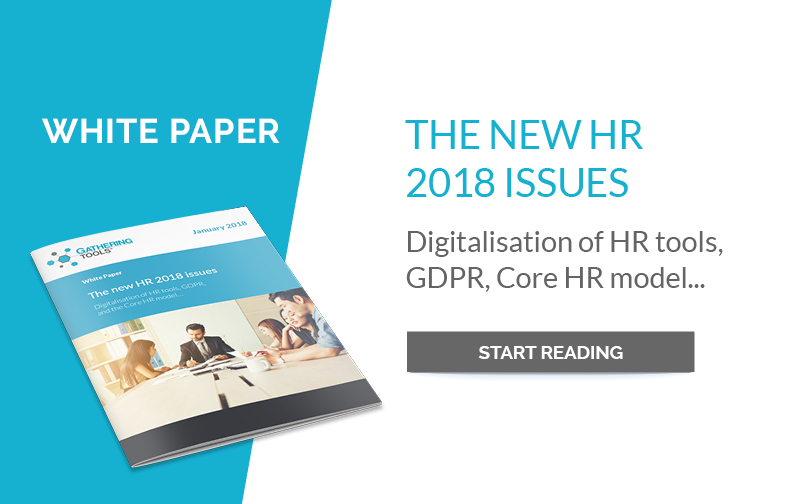Digitalisation has become part of the constituent of a company. It has entered all departments and the vast majority of businesses. It transforms the processes but also the managerial functions, the report of the employee to the company, etc. Given this observation, it is logical to think that human resources are deeply impacted by this digital transformation. However, it is not uncommon to hear that the HRD remains a protective of “old-fashioned” methods, resistant to change, in search of “digital skills”. So, is this a myth or a reality?
The digitalization of HR function
 The digitalization of the HR function is a necessity for the company. And, good news, HRDs are fully aware of it. According to a Deloitte study, it is up to the HRD to pervade the culture of digitalization within the company! In these circumstances, it is impossible to say that human resources are far from digital concerns. Except that it’s not so simple.
The digitalization of the HR function is a necessity for the company. And, good news, HRDs are fully aware of it. According to a Deloitte study, it is up to the HRD to pervade the culture of digitalization within the company! In these circumstances, it is impossible to say that human resources are far from digital concerns. Except that it’s not so simple.
Indeed, there is “say” and “do” and in terms of action, the tone is not the same: only a third of HRD believe they have the ability to adapt easily to digital transformation, and nearly one in two think that HRD does not have a good understanding of the challenges of digital skills development, according to the Deloitte study. Of course, some HR missions are slowly starting to digitize as training or recruitment, proof that the HRD are engaged in this transformation. However, other key areas suffer from this context, such as the HR analytics part, an example of the backlog.
The HR data are still too little exploited
 Human resources are seated on Ali Baba’s cave of data of all kinds such as numbers, payroll, turnover, gender balance, etc. But, this is not free of problems. Because HR Oftenly do not know how to exploit data and share them. According to another study **, 37% of HRDs consider that they do not have indicators to measure the performance of their function. In fact, 72% of them follow fewer than 10 indicators in their department. Most of the time it is the indicators that serve to operate the “social management control”.
Human resources are seated on Ali Baba’s cave of data of all kinds such as numbers, payroll, turnover, gender balance, etc. But, this is not free of problems. Because HR Oftenly do not know how to exploit data and share them. According to another study **, 37% of HRDs consider that they do not have indicators to measure the performance of their function. In fact, 72% of them follow fewer than 10 indicators in their department. Most of the time it is the indicators that serve to operate the “social management control”.
The reason for this lack of data exploitation mainly invoked by the lack of suitable computer tools. Results are, very few indicators, as we have said, but also indicators calculated on the basis of incomplete data. 41% ** of respondents report owning incomplete information on skills mapping and 39% ** on employee activity, for example.
Indeed, in 37% ** of the companies, the feedback of field information necessary for the HR indicators calculations is done by transfer of files. It is therefore difficult under these conditions to make reliable analyses. The risks of human errors related to consolidation are numerous, the consistency of data between different files, often Excel type, hard to verify. So, how to proceed?
Solution to smoothly digitize the HR
 Even for companies equipped with automated solutions, the construction of reliable indicators is a priority issue. For 51% of HRD **, the IT tools at their disposal to develop indicators are not satisfactory. Therefore, according to the same study, it is often the spreadsheet that is considered the best HRIS! Indeed, 65% ** of HR managers believe that one of the main obstacles to the implementation of HR indicators is that it is difficult to reconcile office files and information systems in place. Fortunately, alternative solutions exist.
Even for companies equipped with automated solutions, the construction of reliable indicators is a priority issue. For 51% of HRD **, the IT tools at their disposal to develop indicators are not satisfactory. Therefore, according to the same study, it is often the spreadsheet that is considered the best HRIS! Indeed, 65% ** of HR managers believe that one of the main obstacles to the implementation of HR indicators is that it is difficult to reconcile office files and information systems in place. Fortunately, alternative solutions exist.
Take the example of data consolidation for Talent Management at Vallourec. In less than 4 months, a solution to automatically collect the data of 21,000 employees was in place! And beyond the simple collection, the quality of data has been greatly improved, the HR teams have gained considerable time and a centralization of all information collected has been put in place. How? With Gathering Tools, an application that converts your Excel workbooks into secure, structured documents while preserving their appearance and functionality.
If you also want to improve the calculation of your HR indicators, increase the frequency of reporting and increase the performance of your HR department, do not hesitate to contact us!



